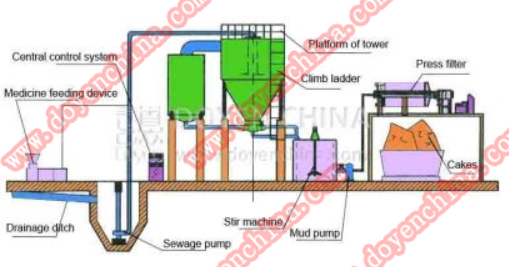

Tel:
+86-757-8633-0278
Email:doyen@doyenchina.com
Fax:+86-757-86287390
Address:Room 201, Building No. 24, Yicui Rose Garden, No. 2, Jihua 7 Road, Chancheng District, Foshan City, Guangdong Province, China 528000.
With the continuous development of science and technology, the various needs of people’s daily life and the needs of social development will also be better met. For the majority of the pharmaceutical manufacturing industry, excessive high-concentration pharmaceutical wastewater will be produced during the production of drugs. If these wastewater cannot be treated well, the harmful substances in the wastewater will continue to diffuse. Therefore, it is necessary to carry out advanced treatment of these wastewaters before discharging these wastewaters, so as to reduce the harm caused by these wastewaters. However, there are still many problems in various advanced treatment processes of pharmaceutical wastewater at present, so that there is no good treatment effect in the treatment process. This article mainly conducts a comprehensive analysis on the advanced treatment process of pharmaceutical wastewater.
1. Research status of pharmaceutical wastewater treatment technology
In the actual production process, anaerobic wastewater treatment technology can be used for anaerobic treatment and aerobic treatment according to the characteristics of pharmaceutical wastewater, so that the advanced treatment of wastewater can be better completed in the end. Only by effectively performing wastewater suppression treatment in the actual operation, can the concentration of the treatment be reduced to the concentration of biochemical suppression, so as to better enhance the biochemical properties of the wastewater. After the biochemical treatment is completed, advanced treatment is required to enable the wastewater to better meet the discharge standards. If you want to better solve the problem of wastewater generated by the company in the pharmaceutical process, you need to formulate a corresponding plan based on the actual requirements of the engineering design, and operate it effectively [1], and then find the appropriate solution after effectively analyzing the characteristics of the wastewater. Wastewater treatment methods.
2. Problems in the original wastewater treatment process
my country’s advanced pharmaceutical wastewater treatment technology has long appeared and has been developed. At present, the treatment technology of this type of high-concentration pharmaceutical wastewater is also constantly developing. Although the treatment process at this stage has made great progress, from the actual treatment process, the effect of the treatment has been improved. For the current majority of pharmaceutical companies, most high-concentration pharmaceutical wastewater treatment technologies still have the following problems in the process of use: First, my country has created new pollutant discharge standards in order to better protect the environment. . However, most of the pharmaceutical companies in my country have not been able to comply with the regulations during the development process, and pollutants always exceed the standard in the process of treating wastewater. Second, the majority of pharmaceutical companies will use repeated treatment to make the polluted water meet the discharge requirements. However, the content of chemical substances in high-concentration pharmaceutical wastewater is very complex, and the content of different substances is also high. If only the original technology is used for processing, it is often impossible to have a better processing effect. It is precisely because of the above two problems in the process. Therefore, only by transforming the advanced treatment process of high-concentration pharmaceutical wastewater can the social environment be better protected.

3. The current main technologies for advanced treatment of pharmaceutical wastewater
3.1 Coagulation sedimentation technology
At present, coagulation sedimentation technology is the most commonly used technology in the domestic wastewater treatment process. This technology can deeply treat pharmaceutical wastewater. It can be divided into the following parts: First, the chemical agents can be dispersed in the water, so that the minute parts in the sewage can be transformed into an unstable separation state, and the overall sewage can be in the form of lumps and flocs. Way exists. Second, when the substances in the sewage form flocs, the coagulation technology can continue to play the role of gravity so that the pollutants can be reduced, and finally it can effectively separate solids and liquids.
Coagulation sedimentation process appeared earlier in our country, so the related equipment is relatively complete, and the operation process is relatively simple. For example, in the process of treating wastewater, 120mg/L of coagulant can be put inside. At this time, the pH value is 8 and the time is 25s, and the overall decontamination rate can reach 89%. Overall, the decontamination efficiency is higher. However, this process does not dissolve the toxicity well, and it is difficult to remove the pathogens inside the microorganisms.
3.2 Membrane separation technology
Membrane separation technology has appeared as early as the 1960s and 1970s. In the process of use, it will also show the characteristics of exquisiteness and concentration, and the entire operation process is relatively simple. Not only the overall operation process becomes more energy-efficient and efficient, but also the operation process can be better controlled. In the process of treating wastewater, reverse osmosis and microfiltration technology can be used to remove bacterial impurities in the sedimentation material and effectively reduce the internal salinity [2]. It is also possible to control the desalination rate at 90% and the water recovery rate at 70% by using reverse osmosis technology.
Generally speaking, the membrane bioreactor can effectively combine the traditional sewage treatment technology with the latest sewage technology to effectively purify the sewage. In the process of treating sewage in a pharmaceutical factory, it was found that the concentration of DO was 8, the removal rate of COD in effluent was 93%, and the BOD removal rate in effluent was 94%. However, in the actual operation process, it was discovered that the technology investment was too large, which made the relevant processing technology unable to perform better.

3.3 Biological treatment technology
The currently used pharmaceutical wastewater treatment technology cannot match the new discharge standards. But biological treatment technology is still the most commonly used treatment technology. At present, biological treatment technology not only has a lower treatment cost, but also has a more stable effect. Aerobic biological treatment technology can neutralize undesirable substances in wastewater. Therefore, in the actual operation process, it is necessary to effectively combine the pretreatment technology and the aerobic advanced treatment technology. In the actual advanced wastewater treatment process, pretreatment technology and oxygen biochemical treatment technology should be effectively combined.
4. Actual case analysis
4.1 Company introduction
A certain pharmaceutical company is a company specializing in the production of proprietary Chinese medicines. The waste water produced in the production process is mainly waste water produced by Chinese patent medicine preparations, health care products and chemical medicine preparations. The pollutants in the wastewater are mainly composed of CODCr, BOD5, suspended solids and other substances. In the actual operation process, the relevant sewage must be treated first to better meet the requirements of environmental construction.
4.2 Water quality analysis
Combined with the actual operation of the project, the wastewater treatment scale can be set to 1,000m3/d. The main operating scale can be maintained at 50m3/h, operating for 20h per day. The water quality standards are as follows: CODCr is controlled at 2 000mg/L, ammonia nitrogen is controlled at 30mg/L, and pH value is controlled at 6-9. After treatment, the water quality should be controlled within the following standards: CODCr is controlled to be less than 60mg, BOD5 is controlled to be less than 15mg/L, and ammonia nitrogen is controlled to be 8mg/L.
4.3 Processing route
In the process of wastewater treatment, due to the high concentration of wastewater discharged by pharmaceutical factories, it is especially not easy to be biochemically. The wastewater also contains a large amount of suspended matter and particles, which cannot effectively remove internal pollutants. Therefore, in the actual treatment process, the characteristics of wastewater can be analyzed first, and then combined with the requirements of wastewater treatment, the “air flotation method + hydrolysis acidification and other methods are combined for treatment. Only when these processes are effectively combined, Only then can the water quality meet the standards.
4.4 Treatment effect
Since the operation of the advanced treatment process equipment for pharmaceutical wastewater, the company has also continued to carry out regular maintenance on the sewage treatment station. All kinds of equipment in the entire system have not failed during operation. The contact oxidation tank is in good operating condition, so there will be good operating results. In the process of treatment, the coagulation sedimentation tank is used directly after the operation of the contact oxidation tank, so that the standard can be better met.
In the process of treatment, it is necessary to avoid more pollutants and odors. Generally speaking, the operation process is relatively simple.
5. Concluding remarks
Firstly, it analyzes the problems in the original wastewater treatment process, and then introduces several commonly used main technologies for advanced treatment of pharmaceutical wastewater, and then analyzes the actual cases in combination with the actual case, hoping to provide a reference for the development of pharmaceutical wastewater treatment technology.

Doyen specializes in providing belt press equipment for the Southeast Asian market. Welcome to visit our workshop and formulate a more scientific plan based on the actual situation of your company. Welcome to visit joyce@doyenchina.com or visit https://www.doyenchina.com.
Mar-02-2021
admin

 +86-757-8633-0278
+86-757-8633-0278 doyen@doyenchina.com
doyen@doyenchina.com Sitemap
Sitemap